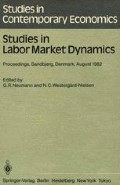Abstract
Unemployment rates of black groups are roughly twice those of white groups, regardless of age, sex, and geographic location. Seeking to identify the labor market flows responsible for this differential, Marston [14] and Ehrenberg [4] use Current Population Survey gross flow data to compute average monthly flow probabilities among the states employment, unemployment, and nonparticipation. They find that blacks and other minorities are more likely to exit employment for unemployment, less likely to exit unemployment for employment, and less likely to successfully enter the labor force.
Access this chapter
Tax calculation will be finalised at checkout
Purchases are for personal use only
Preview
Unable to display preview. Download preview PDF.
References
Bowers, Norman. “Have Employment Patterns in Recession Changed?” Monthly Labor Review, Vol. 104, No. 2, February 1981, pp. 15–28.
Burdett, Kenneth and Nicholas M. Kiefer, Dale T. Mortensen, and George R. Neumann. “Earnings, Unemployment, and Allocation of Time Over Time,” Northwestern university mimeo, January 1982.
Clark, Kim B. and Lawrence H. Summers. “Labor Market Dynamics and unemployment: A Reconsideration,” Brookings Papers on Economic Activity, 1979:1, pp. 13–60.
Ehrenberg, Ronald G. “The Demographic Structure of unemployment Rates and Labor Market Transition Probabilities,” Cornell University mimeo, July 1979.
Elandt-Johnson, Regina C. and Norma L. Johnson. Survival Models and Data Analysis. John Wiley & Sons, New York, 1980.
Flinn, Christopher J. and James J. Heckman. “New Methods for Analyzing Individual Event Histories,” University of Chicago mimeo, April 1981.
Glossary of Variable Descriptions for the SIME/DIME10th Monthly Family-Person Files, Mathematica Policy Research, Inc., Washington, D.C.
Hall, Robert E. “The Importance of Lifetime Jobs in the U.S. Economy,” American Economic Review, Vol. 72, No. 4, September 1982, pp. 716–24.
Hall, Robert E. “Turnover in the Labor Force,” Brookings Papers on Economic Activity, 1972:3, pp. 709–56.
Heckman, James J. and Burton Singer. “The Identification Problem in Econometric Models for Duration Data,” mimeo, December 1980.
“Jobseeking Methods Used by American Workers,” U.S. Department of Labor, Bureau of Labor Statistics, Bulletin 1886, 1975.
Kalbfleisch, John D. and Ross L. Prentice. The Statistical Analysis of Failure Time Data. John Wiley & Sons, New York, 1980.
Lundberg, Shelly. Unemployment and Household Labour Supply. Northwestern University doctoral dissertation, June 1981.
Marston, Stephen T. “Employment Instability and High Unemployment Rates,” Brookings Papers on Economic Activity, 1976:1, pp. 169–203.
Mincer, Jacob and Boyan Jovanovic. “Labor Mobility and Wages,” in Studies in Labor Markets, Sherwin Rosen, editor, University of Chicago Press, 1981.
Muus, Lars. “Incidental Parameters and Generalized Residuals in Models of Duration Processes,” Northwestern University mimeo, June 1982.
Storey, James R. “Welfare in the 70’s: A National Study of Benefits Available in 100 Local Areas.” Studies in Public Welfare, Paper No. 15(A Staff Study prepared for the use of the Subcommittee on Fiscal Policy of the Joint Economic Committee, U.S. Congress), July 22, 1974. U.S. Government Printing Office, Washington, D.C.
Tuma, Nancy B. and Philip K. Robins, “A Dynamic Model of Employment Behavior: An Application to the Seattle and Denver Income Maintenance Experiments,” Econometrics. Vol. 48, No. 4, May 1980, pp. 1031–52.
Author information
Authors and Affiliations
Editor information
Editors and Affiliations
Rights and permissions
Copyright information
© 1984 Springer-Verlag Berlin Heidelberg
About this paper
Cite this paper
Weiner, S.E. (1984). A Survival Analysis of Adult Male Black/White Labor Market Flows. In: Neumann, G.R., Westergård-Nielsen, N.C. (eds) Studies in Labor Market Dynamics. Studies in Contemporary Economics, vol 11. Springer, Berlin, Heidelberg. https://doi.org/10.1007/978-3-642-88315-6_6
Download citation
DOI: https://doi.org/10.1007/978-3-642-88315-6_6
Publisher Name: Springer, Berlin, Heidelberg
Print ISBN: 978-3-540-13942-3
Online ISBN: 978-3-642-88315-6
eBook Packages: Springer Book Archive

